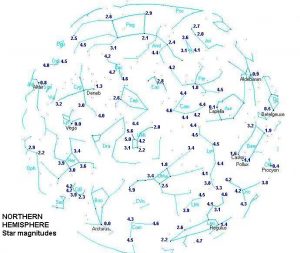This question popped up at our quarterly meeting on 17 February. To answer it, take the following steps…
- Use a low power eyepiece to observe the star of interest.
- Choose a star in the sky which appears to be of similar brightness when seen with the unaided eye to the star seen in the eyepiece and whose magnitude you know.
- Add a figure appropriate to your telescope.
Simple? But:
Q. “Why use a low power eyepiece?”
A. High power eyepieces increase the contrast of the star against the background sky, making it easier to see and resulting in a lower estimate of the magnitude.
Q. “Am I expected to know the magnitudes of all the stars in the sky?”
A. No. The accompanying chart of the northern hemisphere will allow you to determine the magnitude of most of the stars visible throughout the year. A North Polar Sequence (such as the stars of Ursor Minor) should not be too difficult to remember, along with the magnitudes of say some really bright stars such as Capella, Arcturus and Vega (all 0m), Aldebaran, Pollux and Altair (all ~1m).
Q. “What figure should I add for my telescope?” A. This depends on the type of telescope and the aperture. Reflectors and catadioptrics have a central obstruction and the mirror coating absorbs more light than an object glass. Coated objectives and eyepieces increase the light transmission. Based on the transmission figures of various types of optical system given on page 90 of the Amateur Astronomer’s Handbook, the following enhancements of magnitude have been calculated for different telescopes using coated eyepieces:
7×50 or 10×50 binoculars assuming all optics coated: 4 mags
Refractors (assuming coated objectives) of aperture:
75mm: 4.8m 100mm: 5.4m 125mm: 5.9m 150mm: 6.3m
Newtonian Reflectors/Catadioptrics (assuming coated correctors) of aperture:
100mm: 5.3m 125/130mm: 5.9/6.0m 150mm: 6.2m
200mm: 6.8m 250mm: 7.3m 300mm: 7.7m
The use of uncoated objectives or eyepieces will result in a reduction of 0.1 m.
Example: A star seen through an 8-inch Dobsonian with a low power uncoated eyepiece seems as bright as Polaris does with the unaided eye:
Polaris has a magnitude of 2.0. An 8-inch (200mm) Newtonian reflector with a coated eyeprice enhances this by 6.8 magnitudes, but the lack of coating means 0.1 mag is lost. So the star in the telescope has a magnitude of 2.0 + 6.8 – 0.1 = 8.7 mag.


